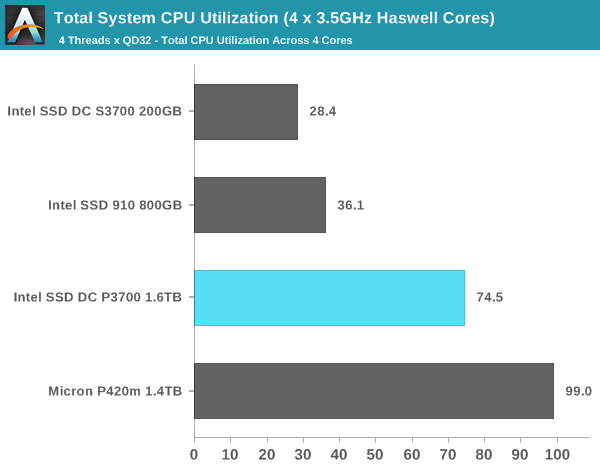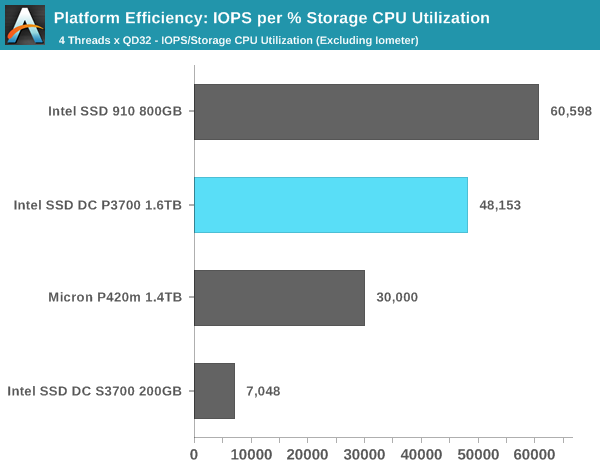Intel SSD DC P3700 Review: The PCIe SSD Transition Begins with NVMe
by Anand Lal Shimpi on June 3, 2014 2:00 AM EST- Posted in
- Storage
- SSDs
- Intel
- Intel SSD DC P3700
- NVMe
CPU Utilization
With the move to NVMe not only do we get lower latency IOs but we should also see lower CPU utilization thanks to the lower overhead protocol. To quantify the effects I used task manager to monitor CPU utilization across all four cores in a Core i7 4770K system (with HT disabled). Note that these values don't just look at the impact of the storage device, but also the CPU time required to generate the 4KB random read (QD128) workload. I created four QD32 threads so all cores are taxed and we're not limited by a single CPU core.

To really put these values in perspective though we need to take into account performance as well. The chart below divides total IOPS during this test by total CPU usage to give us IOPS/% CPU usage:

Here all of the PCIe solutions do pretty well. The SATA based S3700 is put to shame but even the Intel SSD 910 does well here.
For the next charts I'm removing Iometer from the CPU usage calculation and instead looking at the CPU usage from the rest of the software stack:


Here the 910 looks very good, it's obviously a much older (and slower) drive but it's remarkably CPU efficient. Micron's P420m doesn't look quite as good, and the SATA S3700 is certainly far less efficient when it comes to IOPS/CPU.










85 Comments
View All Comments
Ryan Smith - Wednesday, June 4, 2014 - link
The Revodrive 3 presents itself as a SAS device as I understand it. In any case the problem isn't that the board can't see the drive period - the ASRock system browser cheerfully identifies it as an Intel drive - it just doesn't consider it bootable. This is with the latest BIOS (3.10) BTW.To answer your second question, none of the other PCIe drives we have are bootable. The Intel 910 is explicitly non-bootable, and the Micron P420m uses a proprietary protocol.
hpvd - Wednesday, June 4, 2014 - link
many thanks for giving that much details!!hpvd - Friday, June 6, 2014 - link
just found a gerat piece of information - maybe you only need the right driver (or windows version where this is included out of the box)"NVM Express Boot Support added to Windows 8.1 and Windows Server 2012 R2"
details:
http://www.nvmexpress.org/blog/nvm-express-boot-su...
hopefully this works for these devices...
Bloorf - Tuesday, June 3, 2014 - link
Thanks for the article. I'm glad the new interface is showing good results so far. People are probably drooling for the new storage hardware options coming eventually.Rob94hawk - Tuesday, June 3, 2014 - link
I personally would like to see results in a dedicated gaming rig.Benjam - Tuesday, June 3, 2014 - link
I think that gaming performance is the least of your concerns with this speed monster.jimjamjamie - Tuesday, June 3, 2014 - link
Minimal loading times and no I/O-related hitching still sounds wonderful though.TelstarTOS - Tuesday, June 3, 2014 - link
Excellent QD1 performance is what matters for a workstation or enthusiast machine, so this is EXTREMELY promising.stevets - Tuesday, June 3, 2014 - link
I would like to see what this could do on an ESXi host running Pernix Data's FVP. If supported, these cards could make that solution much more affordable from a hardware perspective.Qasar - Tuesday, June 3, 2014 - link
are these types of drives only going to be on PCIe.. or are sata-express drives planned as well ?? depending on ones usage... finding a PCIe slot to put a drive like this in.. may not be possible, specially in SLI/Crossfire... add the possibility of a sound card or raid card..